





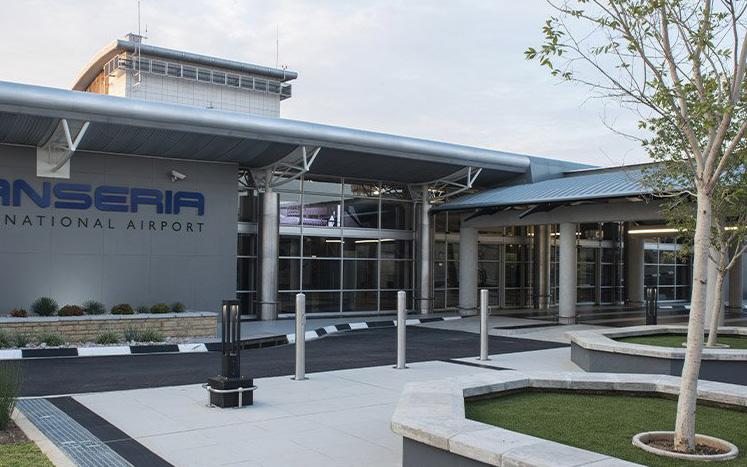

Despite having lost two of the three scheduled airlines that used to operate out of Lanseria, the airport is scaling up to be able to handle additional airlines and more scheduled flights.
COVID AND THE SUBSEQUENT collapse of Comair and Mango left FlySafair as the only scheduled airline at Lanseria. Safair offers lowcost domestic flights from Lanseria to Durban and Cape Town. FlySafair Head of Marketing Kirby Gordon explains that the airline is finding
steady demand returning for its key Lanseria to Cape Town and Durban routes. As the fleet grows with recent deliveries and more aircraft become available, it will also reopen its George pairing, but he explains that there is no firm date for that route reopening.
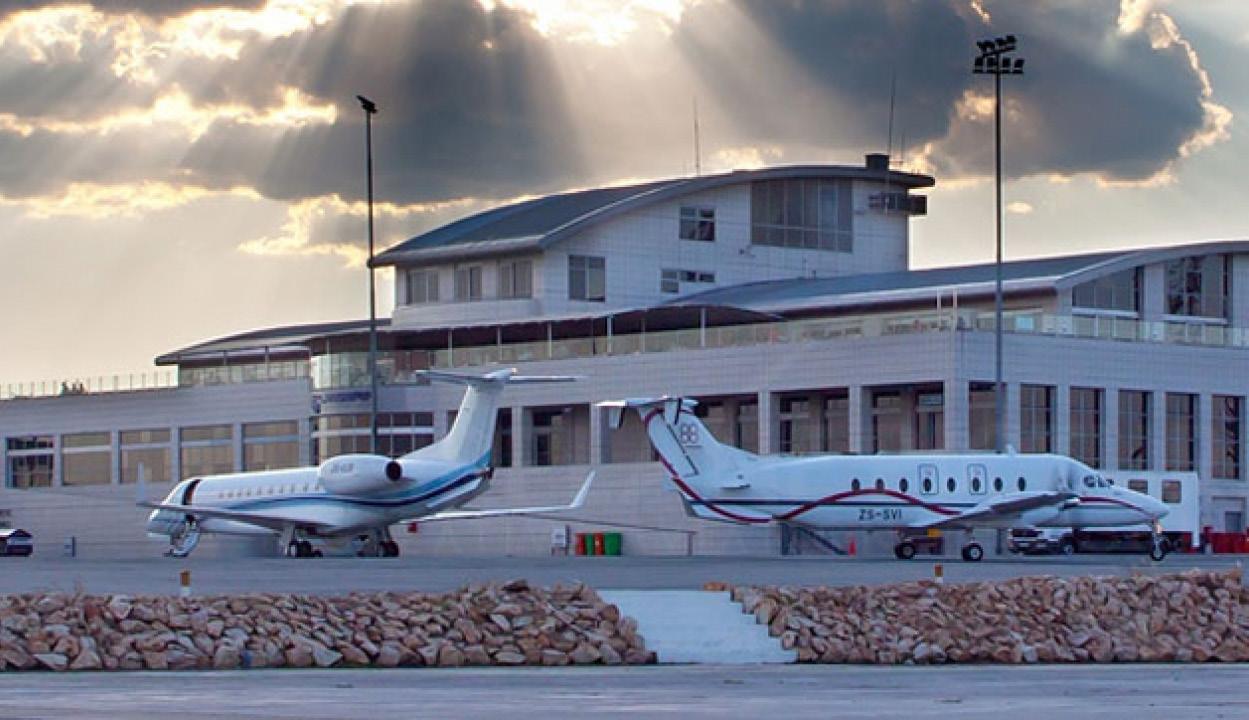
Gordon explains that Lanseria is key to FlySafair’s return to pre-2019 operational levels. As a low cost carrier, they have traditionally focussed on the secondary airports.
Overall, Gordon rates Lanseria highly in terms of customer satisfaction. He says that the airline is happy with its Lanseria operations and finds the airport management accommodating. He is particularly complimentary about the airport’s ground handling as it provides this key service itself – rather than outsourcing it to a contractor.
The planned new developments include the construction of new Fixed Base Operator (FBO) facilities, as well as the establishment of new Maintenance, Repair and Overhaul (MRO) facilities at the airport. There are also plans to upgrade Taxiway Alpha to accommodate larger aircraft.
However, the airport has announced that several new developments are in the pipeline to expand the airport so it can handle more airlines and passengers.
There are also plans to establish a fuel farm to add approximately 6 million litres of JetA1 fuel and Avgas to the current 1 million litre capacity. By adding such facilities, the airport intends to attract more airline operators to Lanseria.
Lanseria Airport’s CEO, Mr Rampa Rammopo, said that the new developments would address many of the limitations that deter some airlines, including South African Airways and Airlink, from operating at the airport.
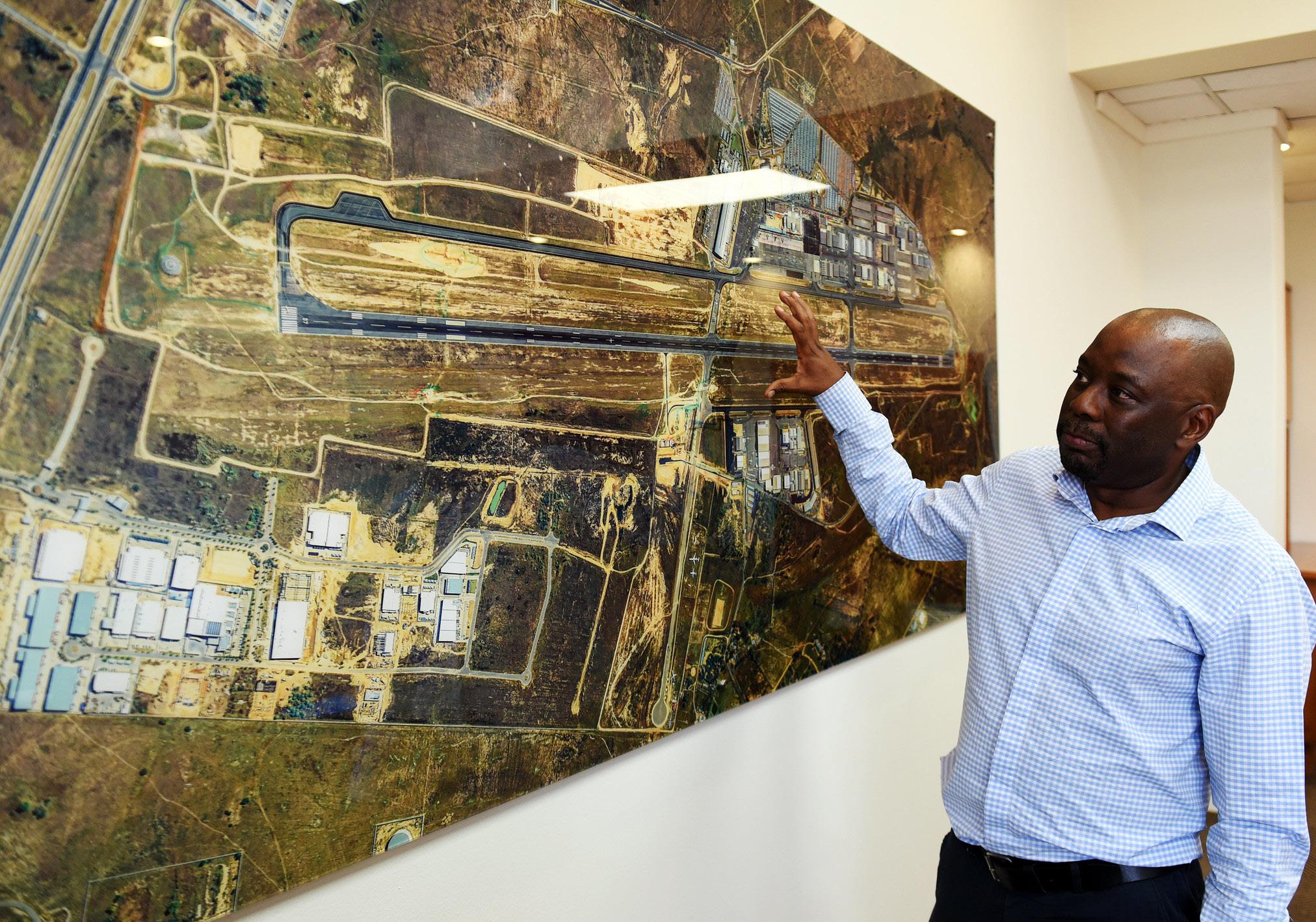
Key recent improvements have been the air gates.
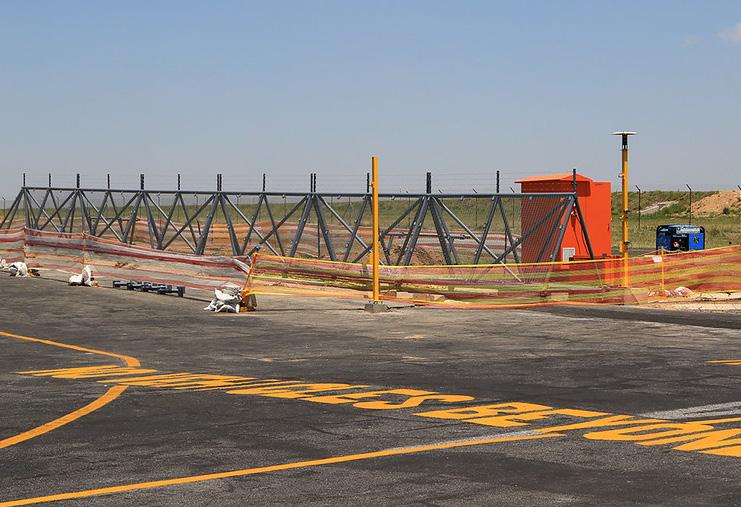
Rammopo said that Lanseria is gearing up to handle more flights from destinations on the African continent. “The comprehensive development projects are set to substantially increase the airport’s capacity to handle additional volumes of traffic by attracting more airlines and expanding the number of routes offered, particularly into other parts of Africa,’ Rammopo said.
With expanded facilities, the airport thus aims to attract more regional air traffic services. According to the Rammopo, this includes new flights to regional destinations in countries including Zambia, Zimbabwe, Mozambique and Mauritius.
Lanseria went through a phase of rapid expansion of its facilities before Covid. Noteworthy are the multi-storey 1,000 bay parkade which is classed as a mini-hub within the airport. In addition to offering more secure covered parking, the parkade also hosts a retail area that includes a bank, car-rental facilities
and restaurants. “We are proud that the parkade serves a multifunctional purpose and increases ease of access to the airport and its offerings,” Rammopo says.
The expansion of the terminal building with a new pier increased the passenger handling capacity from 3 million to 4.5 million per annum. Another major recent development was the opening of the new control tower and fire station on the south side of the airport. “All of these investments have positioned Lanseria well for a full post-Covid recovery in both GA and airline ops.” Rammopo says.
Rammopo believes that by establishing more flight routes, Lanseria could indeed play a significant role in making the country and the continent more accessible for tourists.
‘This enhanced connectivity is expected to attract a higher volume of international visitors,
boosting the tourism sector in South Africa,’ he said.
South Africa is seeing growing numbers of international visitors travelling to the country. Data shows that just under 4 million travellers were recorded at South African ports of entry and exit in the first part of 2024. South Africa’s tourism grew by 9.7% to about 3.8 million arrivals between January and May 2024, according to Tourism Minister Patricia de Lille.
Lanseria is passionate about developing the next generation of aviation professionals.
As part of Mandela Month, Lanseria launched its inaugural Mandela Day Career Expo, welcoming 300 learners from the surrounding area and communities – inspiring the next generation of aviation professionals.
“While the aviation sector remains under pressure, this is a space that unlocks transport, travel and tourism. As such, there are so many related and valuable career options available to all of the learners who attended,” notes Sphiwe Masuku, Fundi’s Head of Brand and Marketing. “Our role was to help bring many closer to finding them, as well as sharing critical
information around funding and the resources available to support them.”
With many high school learners facing critical choices regarding subjects, tertiary institution selection and funding applications, it is essential that they are guided to make the best possible, most informed decisions. “South Africa’s high first year drop-out rate, as well as ultimate throughput rate at most tertiary institutions is evidence of this,” explains Masuku.
“Because so many students still don’t have access to the resources or experts they need to make arguably some of the most important decisions of their lives, many live to regret what they chose. In a best case scenario, they might find that subjects could be carried over into another field of study. In the worst case, they could complete a degree that will unfortunately not move them towards their ideal career or end up giving up and dropping out – carrying study debt well into the future.”
Rammopo says ; “We have taken a strategic decision to continue to support general aviation going forward. We will continue to cater for GA through infrastructure and stakeholder relations.”
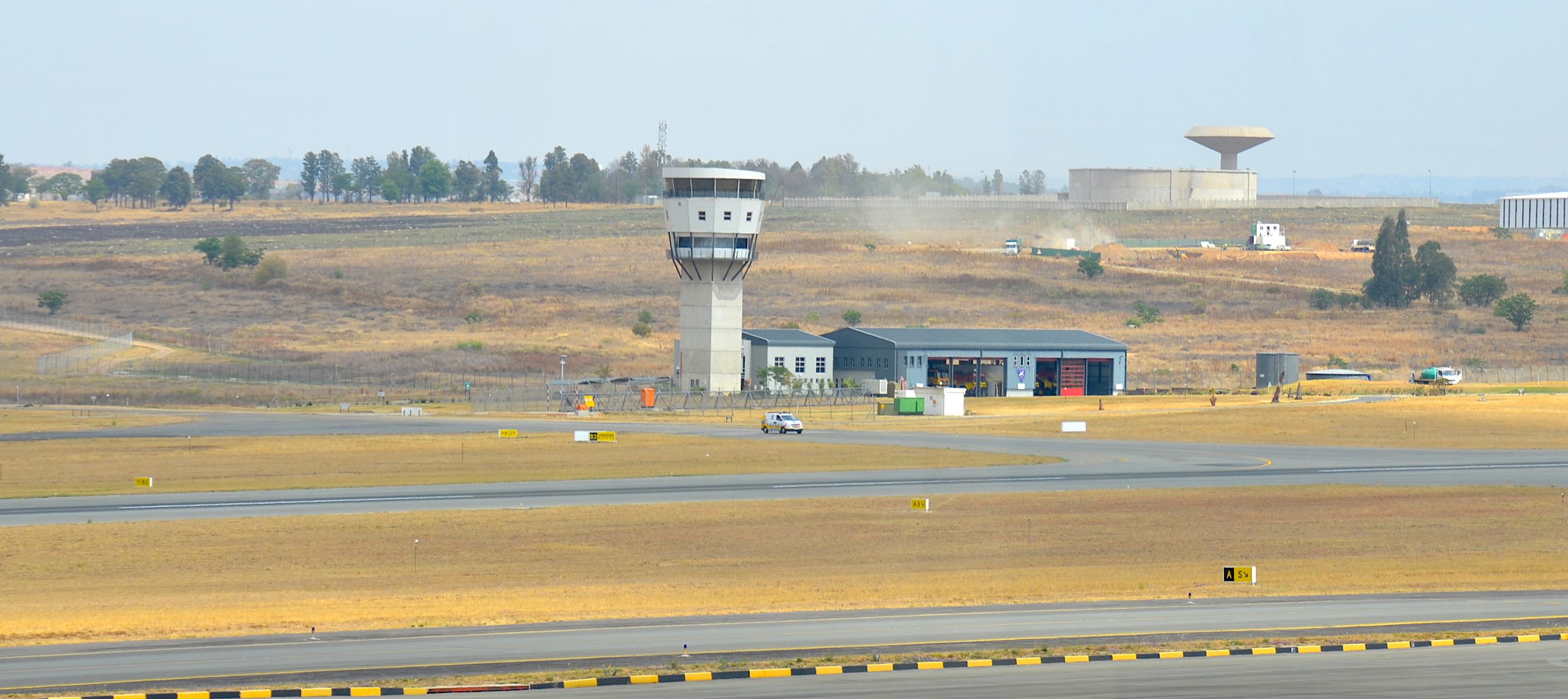
Lanseria hosts world class operations, such as Skyhawk Flight School which has partnered with the Sakhikamva Foundation to spread the love of flying.
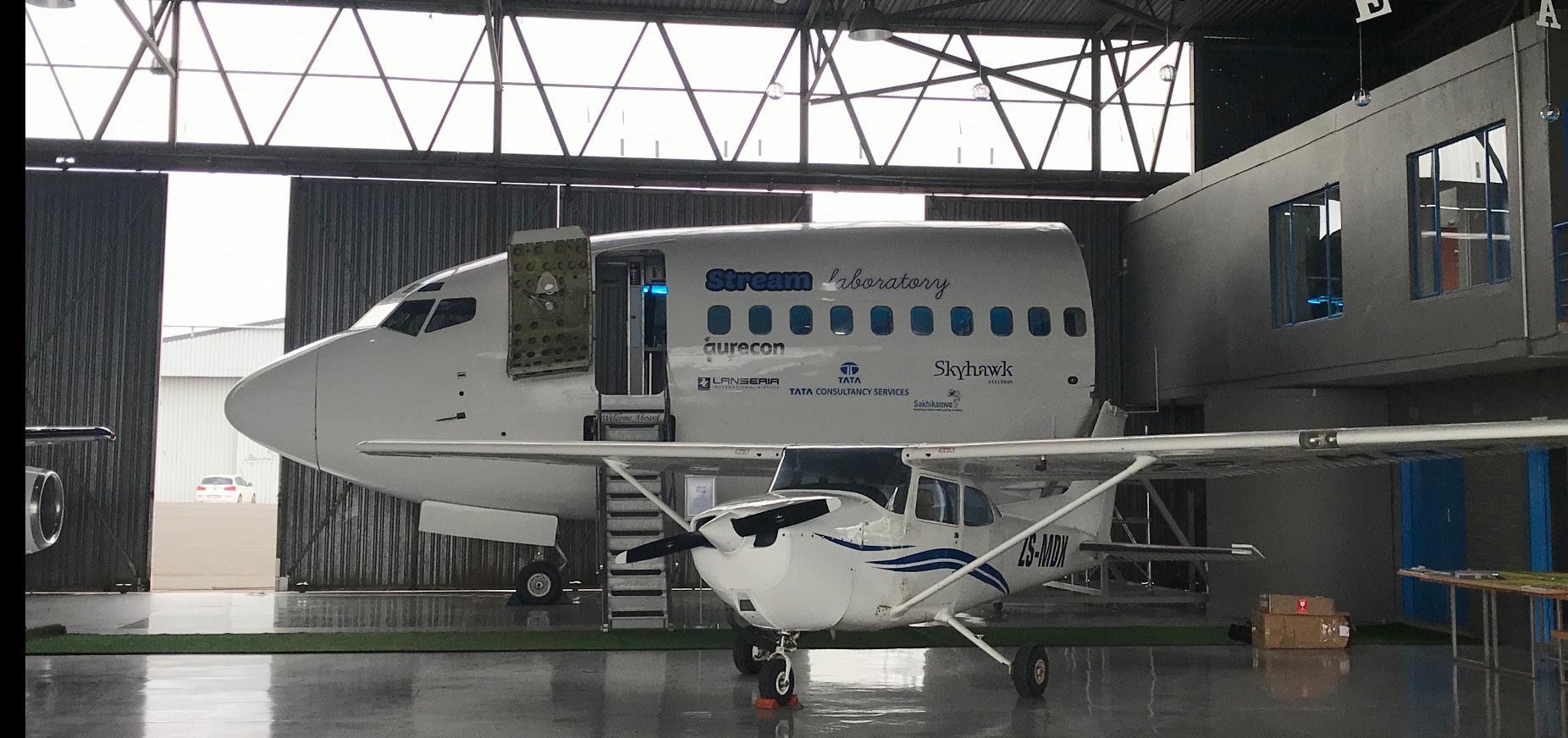
The squeeze on GA is an unavoidable consequence of growth. However, Rammopo points out that the lighter side of GA is not discriminated against and is far from discouraged. He says that flight schools have enjoyed discounted charges from the airport’s inception. “The airport looks after the bottom end of aviation because this is the breeding ground for top end aviation.”
To facilitate GA operations the airport created an Air Operations Centre (AOC) which is a onestop point of call for all GA movements. The AOC is there to help pilots arrange requirements such as apron parking bays, fuel and baggage handling. It has also purchased a modern ATIS system and will provide a central information clearing service, ranging from airspace information to the condition of runways. The new centre is managed by the friendly and knowledgeable Mike Christoff and is staffed by either a qualified air traffic controller, or pilots.
Despite the still recovering level of activity and in particular, airline flight movements, it is reported that a constraint to further growth is air traffic control limitations, which limits the maximum circuit capacity to just two aircraft. This is a constraint on the growth of training operations for the four flight schools at the airport. Rammopo says that airport management
is working with ATNS to increase ATC capacity and skills.
A key consideration is that as the airport has grown and handled more international movements, so its security standards have had to be raised.
The core of the problem is that security requirements for an international airport make access difficult for General Aviation users. The challenge faced by management has been to find the balance between tight security measures and user-friendliness and convenience.
One of the on-going bones of contention has been the ever more onerous security arrangements. Most often the security standards are imposed by external authorities, thus the current security arrangements come from the NIDS – the National Inter Departmental Structure – which, in 2000, set standards for International Airports and cut down the number of ports of entry. Later these standards were adopted by the NASP – the National Aviation Safety Plan.
j
In 1972 two entrepreneurs, Fanie Haacke and Abe Sher saw the need for a new airport north west of Johannesburg. They identified the Lanseria site due to its location in relation to residential areas, suitability for long runways with good approaches, and weather. They persuaded the Krugersdorp and Roodepoort Municipalities, as well as the Transvaal Peri-Urban Board, to buy the land and then let the newly formed Lanseria Management Company use it on a 99-year lease.
THINGS MOVED FAST. Lanseria Airport was opened by the then Minister of Transport, Hannes Rall in April 1974.
On 16 August 1974 a Learjet, ZS-MTD, became the first jet to land at Lanseria. The next year Lanseria hosted the Air Africa International Airshow, which has in turn grown to become AAD, the African Aerospace and Defence expo. The State President’s Air Race was hosted by the airport for a number of years.
In 1990, Lanseria’s then co-owners, the Roodepoort and Krugersdorp Municipalities and the Transvaal Administrator, announced that the
airport was to be sold. Tenders for the ownership and management of the airport were issued and the tender was awarded to a consortium of private investors in 1991.
By 1999 the continued growth in the number of operators, passengers and freight volume utilising Lanseria put heavy pressures on the existing infrastructure. An expansion programme was needed and in 2002 the original ‘corrugated iron’ terminal building was replaced by a much larger and more modern structure that included increased capacity for international passengers, many of whom use Lanseria as a departure point for neighbouring countries like
Lanseria is a catalyst for new Industrial Parks around it.
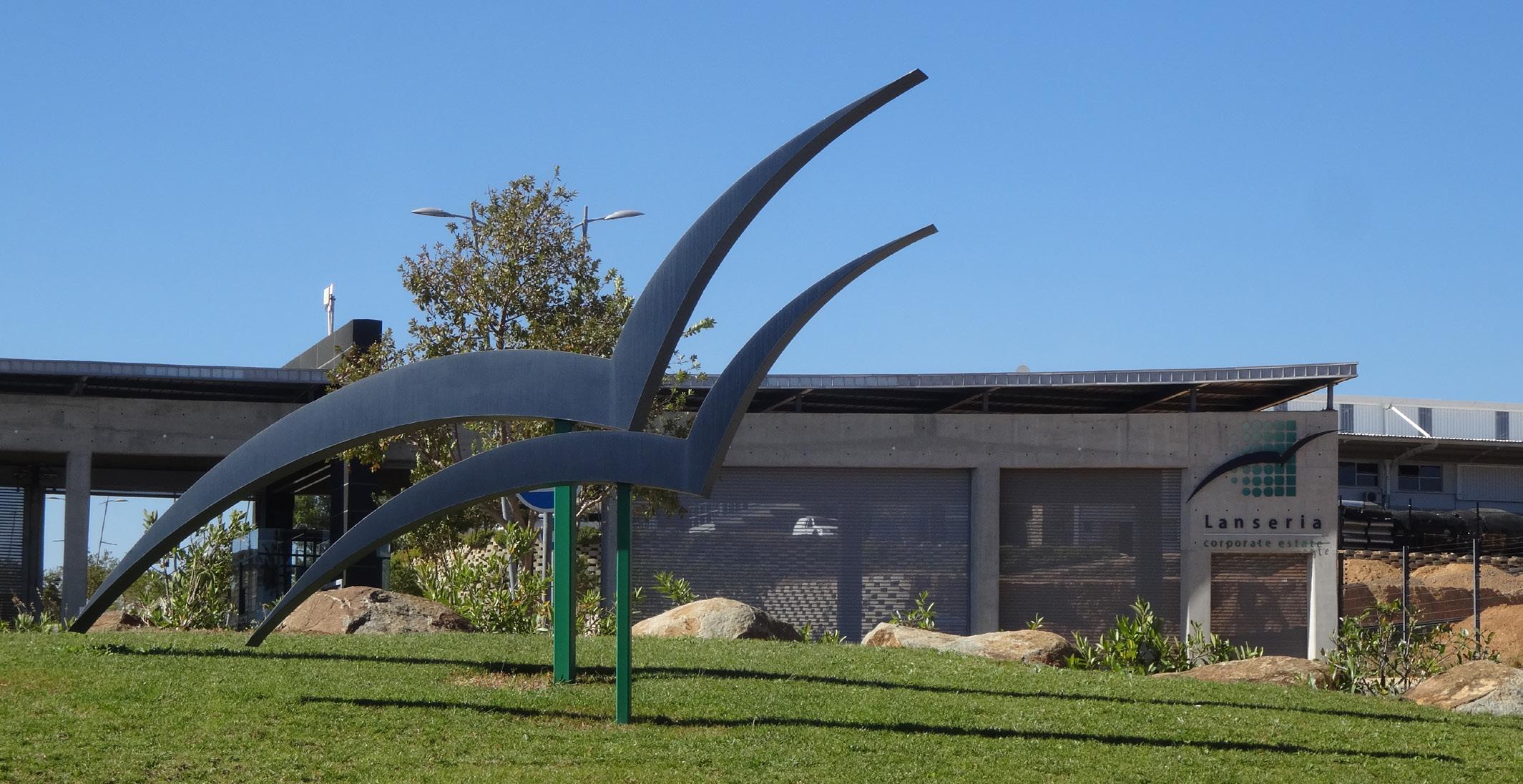
Mozambique, Zimbabwe, Botswana, Swaziland and Angola. The new terminal boasted a dutyfree shop, additional restaurant and coffee shops, and a dedicated observation deck for visitors.
In 2010, the domestic departure area was revamped and enlarged to accommodate the overwhelming demand for scheduled flights to and from Durban and Cape Town.
A key facility at Lanseria has been its permanent customs and immigration facility. All South African port of entry airports had their international status reviewed in February 2001. The nine ACSA operated airports and the privately owned Lanseria were the only airports to retain their international status.
The big infrastructure change was to the runway. The original runways were built to a 30-metre width in terms of ICAO Annex 14. However, this is a bit tight for Boeing 737-800 operations, for which a 45m wide runway is preferred. The
original runway was also getting old and the cost of on-going maintenance made the capital cost of a new runway an attractive option.
Because the airport could not close the original 06L- 24R runway to upgrade it, a new 45-metrewide runway was built between the existing runways. Due to space restrictions it could however, not be longer than the current 2918m of the existing 06L/24R.
The new runway was a major step forward in that it has a better ILS (without the scalloping of the original one) and improved integration into Johannesburg airspace. When it was completed the two existing runways were closed. Later the control tower and fire station were moved to the south side.
The change to a single runway did not have a significant impact on General Aviation. Other large airports, such as Cape Town International, are successfully able to mix light GA operations with airline operations.
Until 1991, the airport was a permanent base for 4 Squadron of the South African Air Force.
During the border wars many aircraft and pilots departed Lanseria for the front line and the airport still plays occasional host to military aircraft. Notable users are the USAF which operates Boeing C-17s and 757s into the airport in support of its diplomatic missions.
The nineties were noted for their steady growth with increasing visits by large aircraft, ranging from Boeing 727s to Russian built cargo aircraft like the Ilyushin Il-76.
The SAAF based a number of museum aircraft at Lanseria and their premises was used as a maintenance and restoration workshop for a number of years. General Jan Smuts’ personal Lockheed was displayed in front of the original terminal building until removed to Air force Base Zwartkop.
In July 2013 Lanseria was acquired by a group of private investors, namely: the Pan African Infrastructure Development Fund (PAIDF) , managed by fund manager Harith, a Black Economic Empowerment consortium led by Nozala, and the Government Employee Pension Fund (GEPF), through the Public Investment Corporation.
As Lanseria is considered a key hub, there are property development plans that embrace a 30 kilometre circle around the airport. The PAIDF has said it is looking to the potential of developments like the Lanseria Corporate Estate that is located close to the threshold of Runway 07.
Lanseria grew to become Johannesburg’s second airport serving airline routes between Gauteng and the Cape. This expansion was a consequence of Comair’s efforts to provide a viable alternative airport for people living on the west Rand and for those frustrated passengers who found OR Tambo Airport too big, expensive and impersonal. Other airlines joined the Lanseria passenger gates. Notable were 1Time and more recently; Mango and FlySafair.
In 2010 the airport building was enlarged further with the addition of boarding gates, an expanded passenger drop-off area and other improvements.
The 2010 improvements laid the groundwork for a significant step-up in response to increased airline activity. This was motivated in part by the nation’s hosting of the 2010 FIFA World Cup. This event saw the dramatic arrival of many business jets from around the world. Lanseria Airport visitors were greeted with the rare sight of Gulfstreams, Global Expresses and many other types of jet aircraft parked on the airport’s grass areas.
The private sector has recognised the key role of the airport and evidence is to be seen in the massive new developments around the airport, including the vast Cradle One complex and exclusive housing estates such as Monaghan Farm and Blair Athol.
A key factor in future growth plans is that Johannesburg City and Gauteng and National government have planned the airport precinct as an industrial node. The airport is now running with its vision with what has come to be called ‘Lanseria Smart City’. The support of local government for the Lanseria Smart City can be seen in the upgrade to the roads servicing the airport. The first phase of the feasibility study has been completed and plans are underway to kick-start the project.
Given the impact of the Covid ‘black-swan’ event, Rampa Rammopo is unsurprisingly coy about how fast he expects the airport to grow in the immediate future, but when pressed, he admitted that they are planning for a return to pre-Covid levels by the end of 2024. j
AERONAUTICAL AVIATION, located at Lanseria International Airport, offers a wide range of expert and innovative solutions in general aviation avionics, maintenance, repairs, overhauls, sheet metal work, and wearable technology. We have strong partnerships with renowned suppliers such as Garmin, Bose, Collins Aerospace, Dynon, Trig, L3 Harris, and Avidyne, allowing us to provide diverse options that meet your budget and operational needs. As Africa’s largest accredited distributor of Garmin and a Garmin Platinum dealer, we are committed to delivering excellence in every aspect of our business.
Our services cater to aviation enthusiasts and professionals, from simple installations to complex integrated flight decks. We specialize in repairs and overhauls and boast one of the most extensive Instrumentation, Gyroscopic, Autopilot, Electrical and Avionics Repair, and Overhaul facilities in Africa. From removing to bench testing, repairing, and overhauling almost everything in the cockpit, including related sensors and transmitters, we are fully equipped to meet all your avionic requirements.
Our CEO, Clinton Carroll, is not only a pilot but also an aircraft owner. With his extensive knowledge of the aviation industry, he understands the challenges faced in the cockpit, regulatory requirements, certification, and the costs associated with operating an aircraft. He can offer valuable insights and advice on upgrading equipment, guidance on panel layout for ease of instrument access, and provide technical and pilot perspectives on repairs and installations while ensuring the highest quality standards.
Aeronautical Aviation is a certified service provider offering line maintenance and inspection services for both Part 91 and Part 135 certified aircraft. We have a highly skilled team of technicians, including Garmin and Collins Aerospace factory-trained technicians, to maintain and repair the aircraft equipment we supply, ensuring your investment is well taken
care of and downtime is minimized.
Our sheet metal division, approved by the SACAA, and our innovative laser department can assist with all your panel fabrication needs. Whether you require the manufacturing of new custom panels, panel refurbishment, or repair and manufacture of backlit and non-lit panels for night flying, we are here to help. We are also capable of customizing and manufacturing switch panels and instrument panels for nontype certified aircraft.
We believe that providing hands-on training to our clients is essential, allowing them to operate the equipment with confidence. With our team of qualified technicians, you can rest assured that you’ll receive top-notch service and support for all your aviation needs, defining the Aeronautical Aviation difference.
In addition to our maintenance and repair services, we also have a pilot shop and aircraft parts section with a large online e-commerce store, offering pilot must-haves, avionics, installation supplies, and maintenance parts.
www.aeronautical.co.za Tel: +27 11 659 1033 sales@aeronautical.co.za
Hangar 202, Gate 7, Lanseria International Airport AMO 1033
j
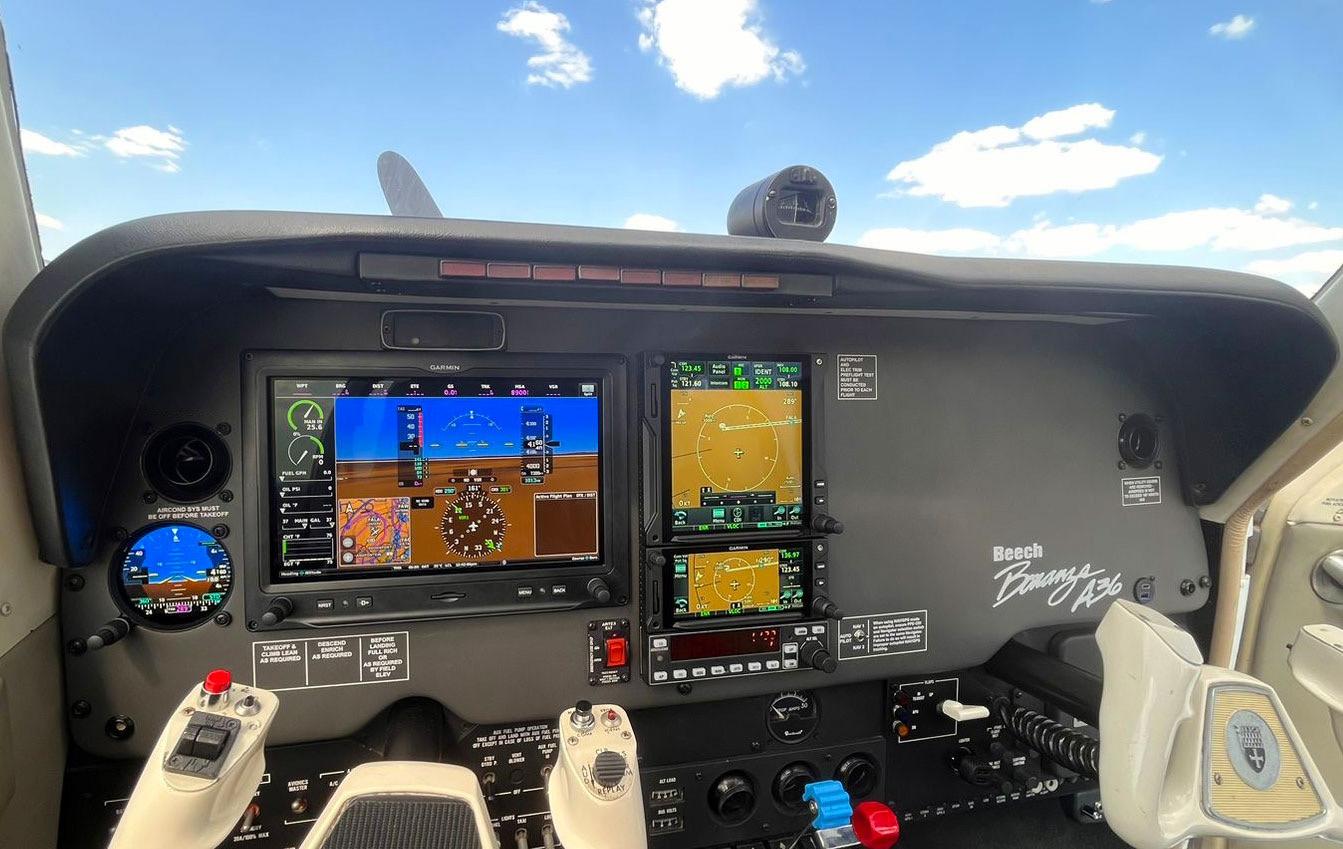
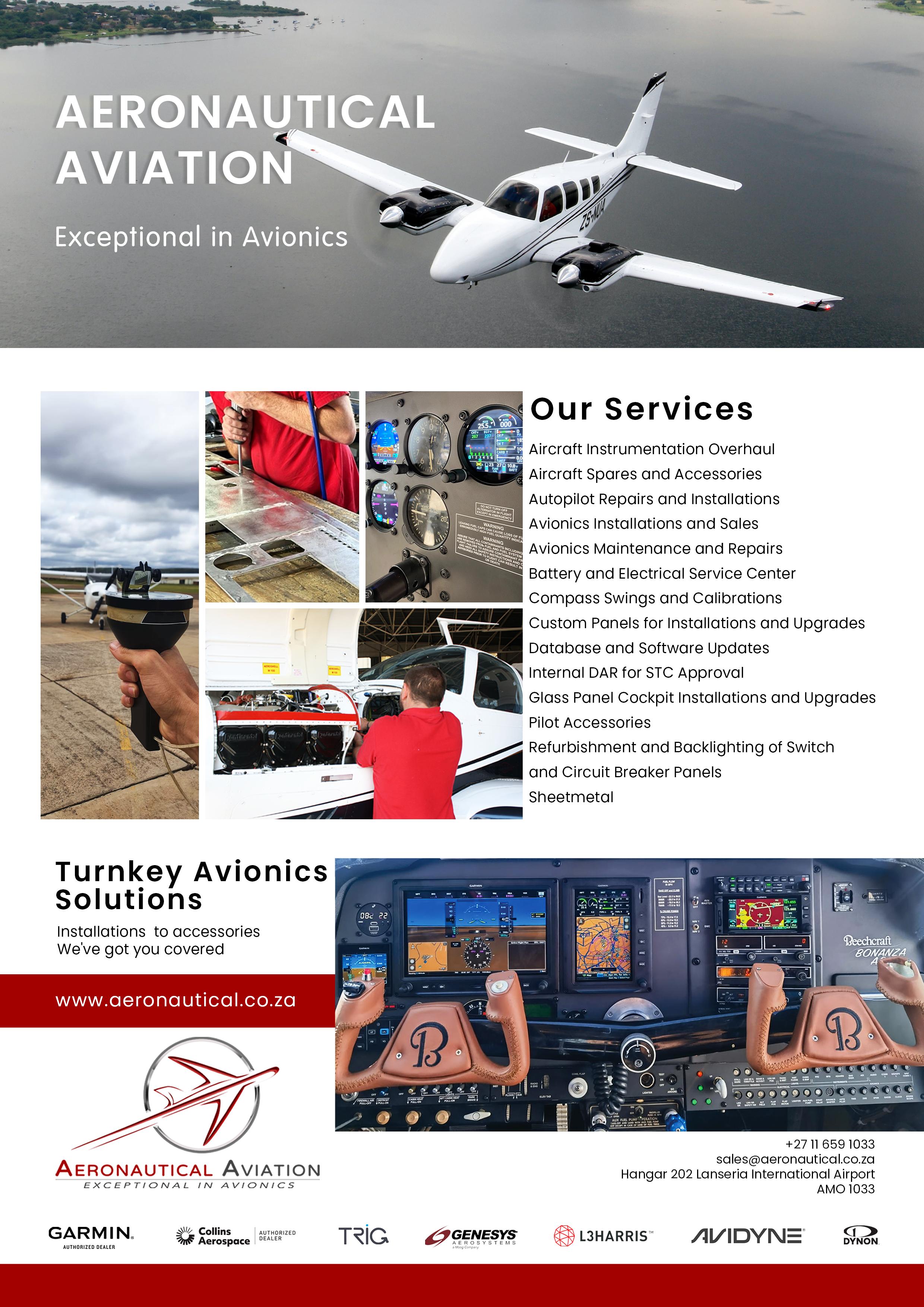



• Now certified for TCAS training.
• RNAV and GNSS Certified on all flight models from single engine to turbine.
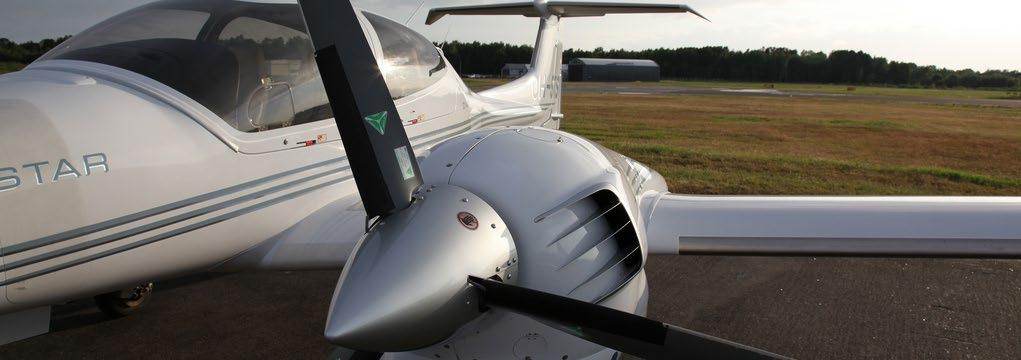
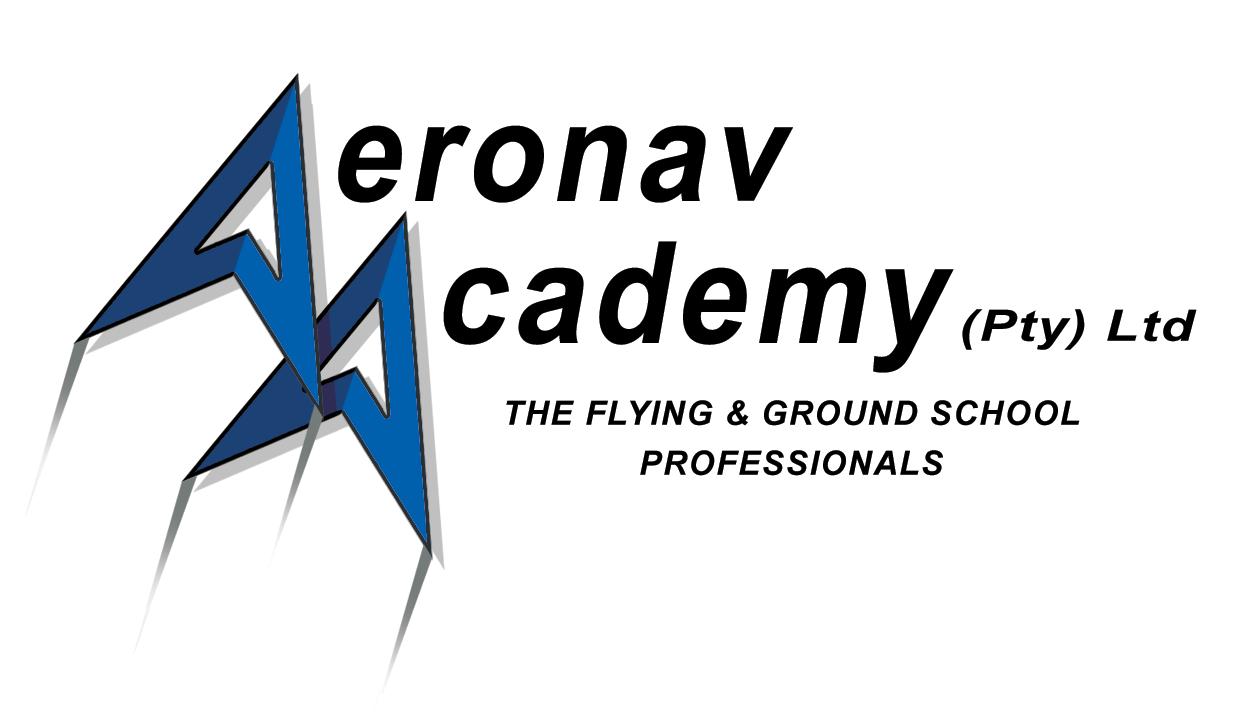
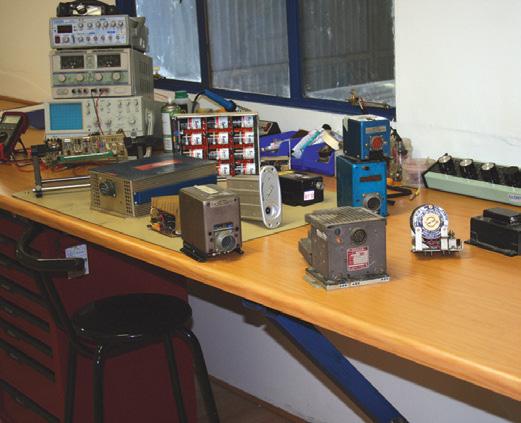
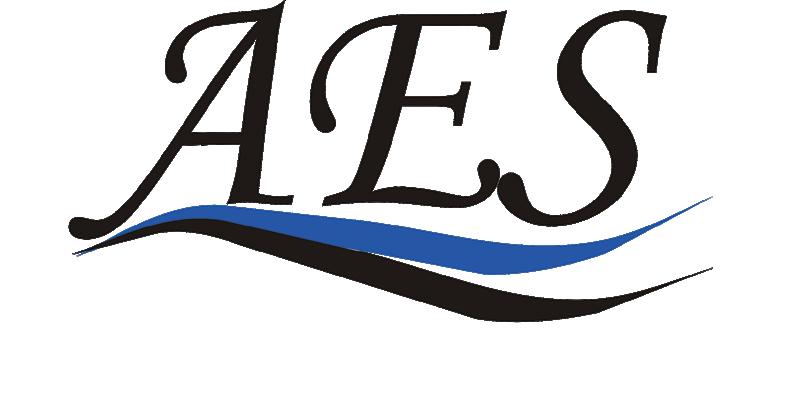


WE SPECIALIZE IN: - Avionics - ACK Agents (ELTs') - Repairing and fault finding in rotor and fixed wing aircraft - Overhaul and repairing of DC/ AC Electrical, Magneto and ignition equipment - Full Battery workshop facilitating NiCad and Lead Acid batteries
- Aircraft electrical modifications and installations - We travel to any destinations for MPI’s and repairs
Danie van Wyk: 083 269 8696 Fax: 011 701 3232
Signature Hanger, Beachcraft Road
Cape Town International Tel: 021 934 5373 Erwin Erasmus: 082 494 3722
Website: www.aeroelectrical.co.za
Email: office@aeroelectrical.co.za

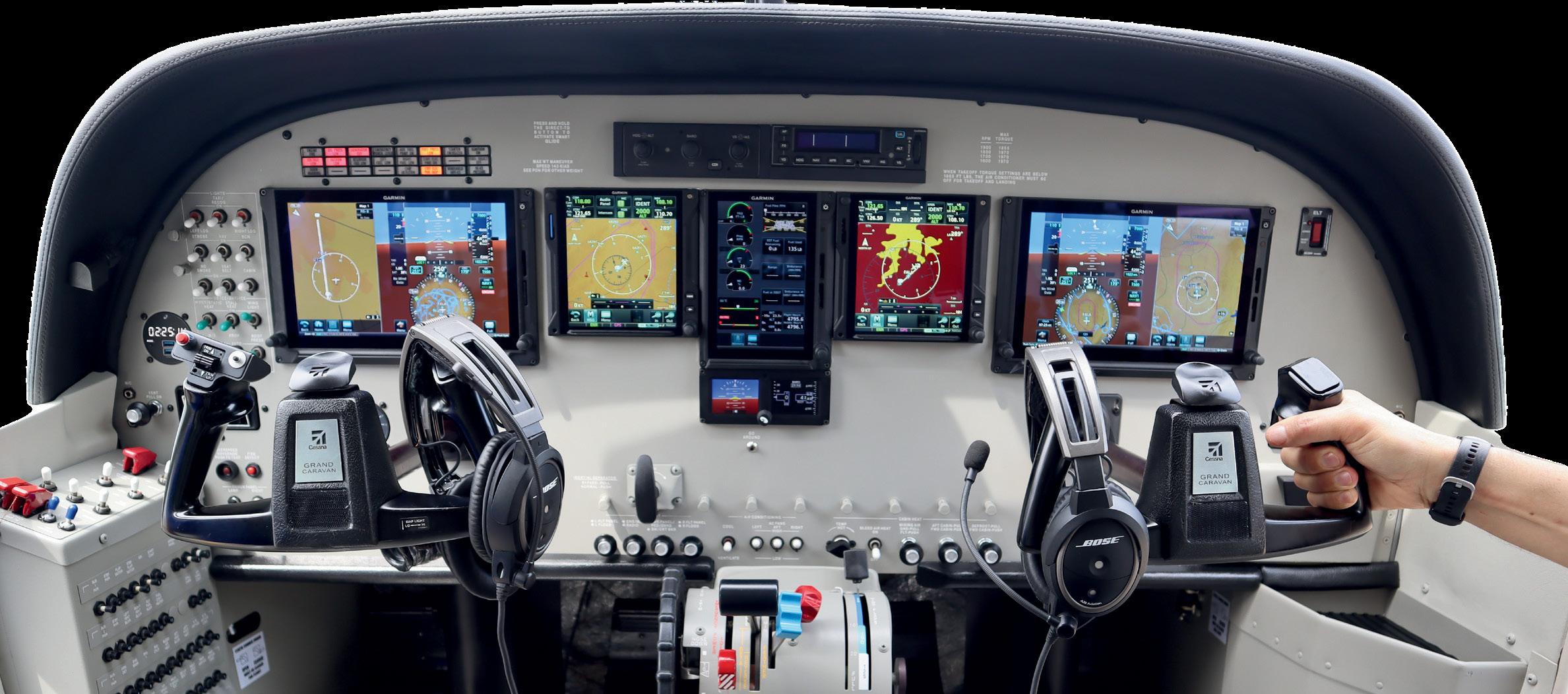



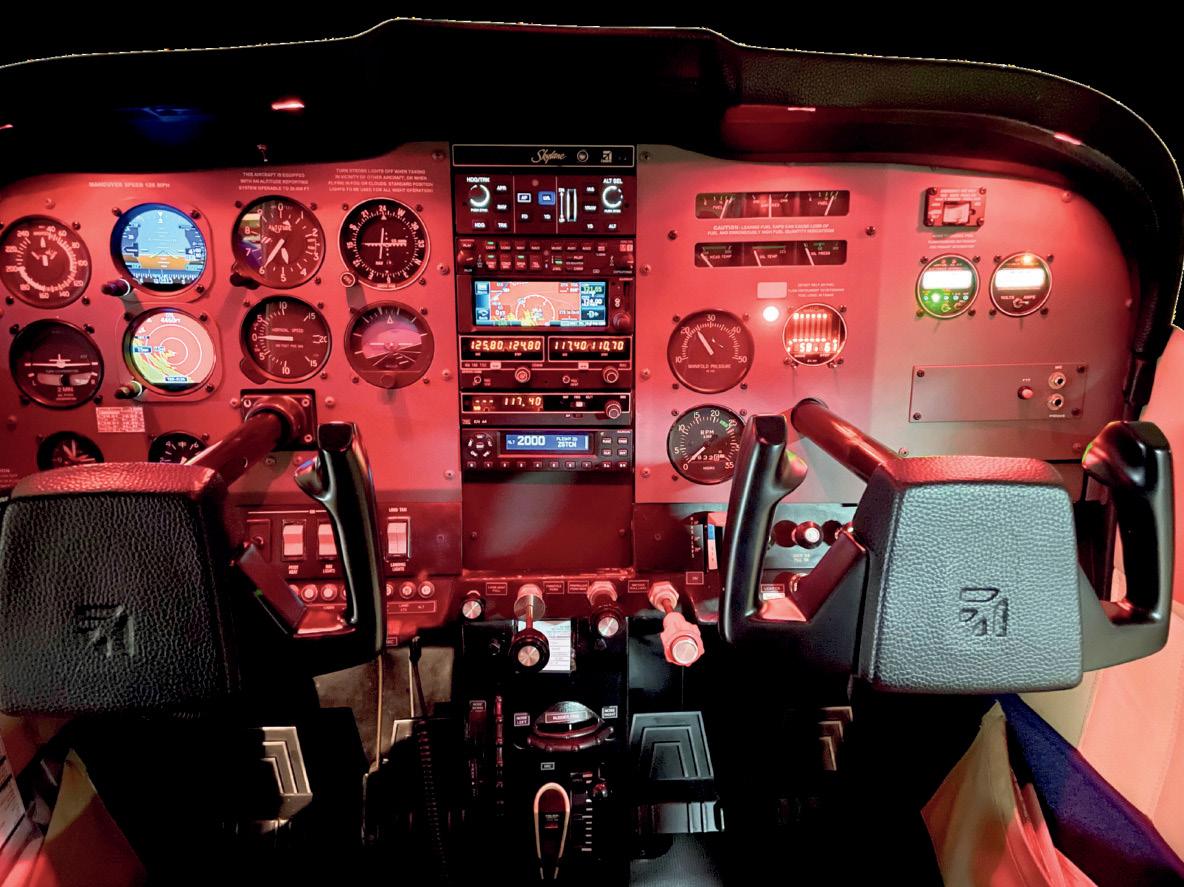
Situated at Lanseria International Airport, Century Avionics focuses on general aviation avionics for both fixed - and rotary-wing aircraft. With over 45 years of experience, Century Avionics stands as a leading privately owned avionics establishment in Southern Africa. Aiming to be a comprehensive avionics hub for the general aviation community, delivering top-notch services all in one place. Working in tandem with their skilled and experienced Certification Department, they support Avionics STC Application / Development and Modification Approvals. Century Avionics boasts an experienced design organization (Century NAVCOM) that is recognized by the South African Civil Aviation Authority (SACAA). Loyal customers can vouch for their professional dedication, promptness, and amicable service.
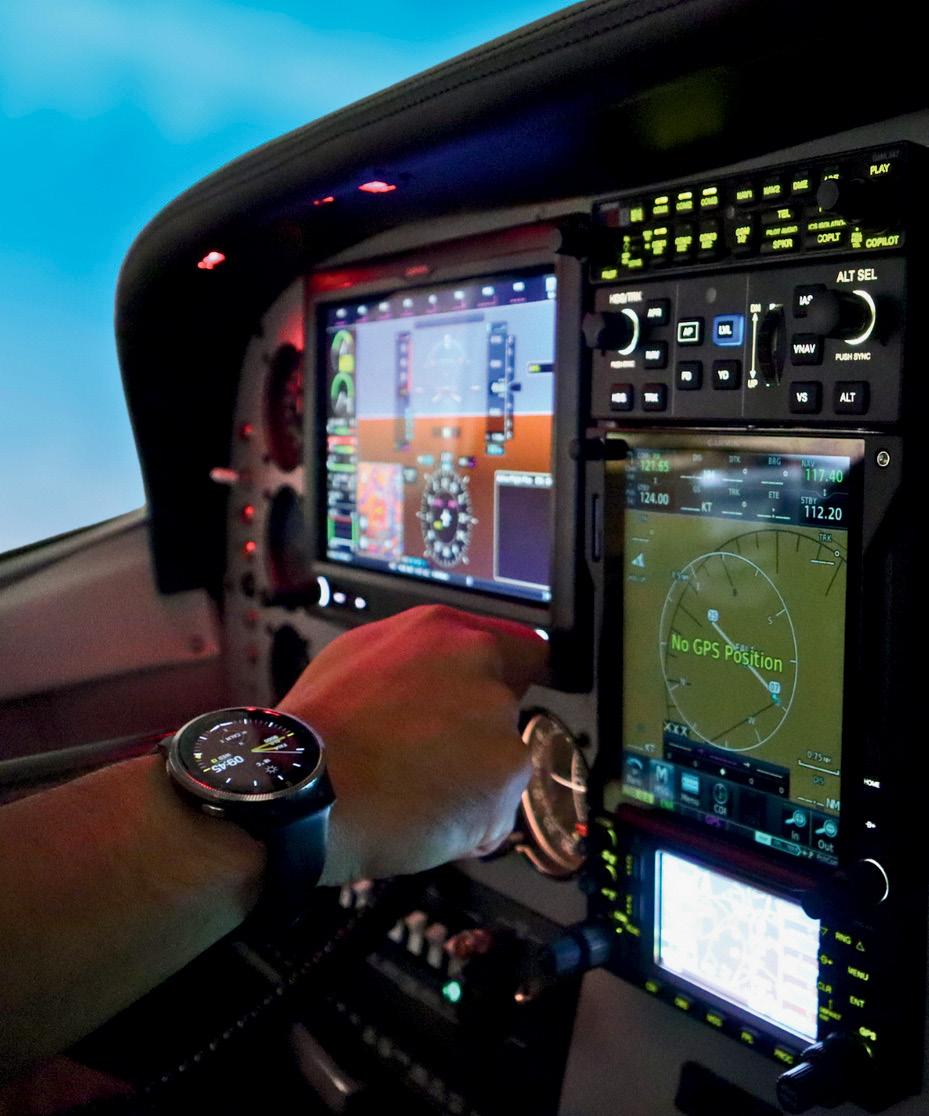
The Aircraft Maintenance Organization (AMO) have secured approval in South Africa, Botswana, Namibia, Kenya, and Zimbabwe, streamlining the avionics installation and approval process for various aviation authorities.




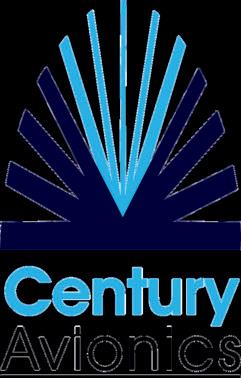
CLICK LOCATION DOTS TO LINK TO INTERACTIVE MAP
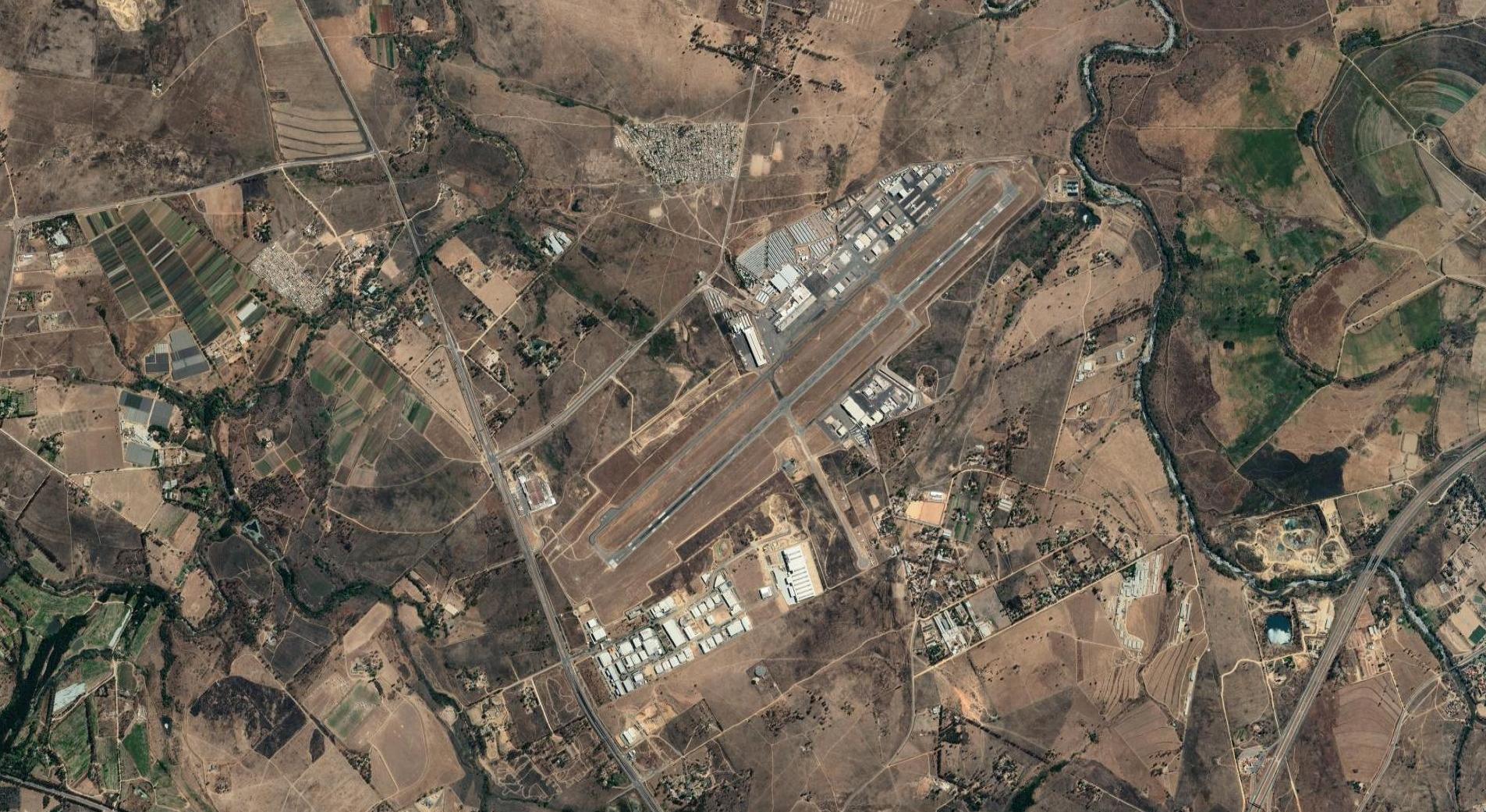
AERONAUTICAL AVIATION
CENTURY AVIONICS
AERONAV ACADEMY
AES STANDARDAERO
EXECUTIVE AIRCRAFT REFURBISHMENT
LANSERIA AIRPORT